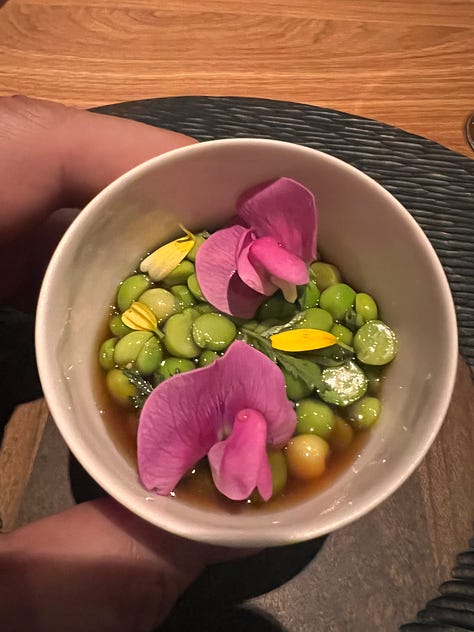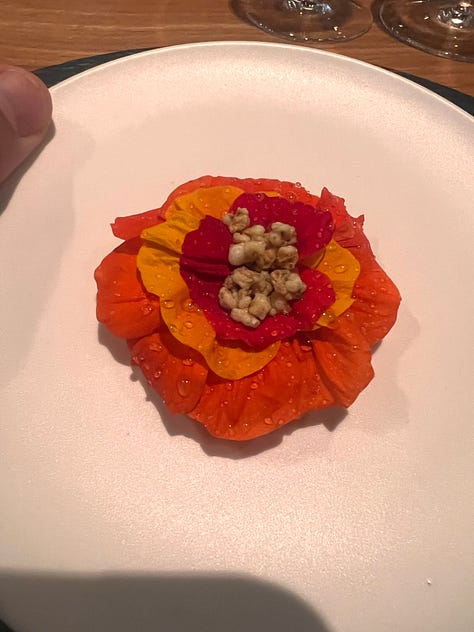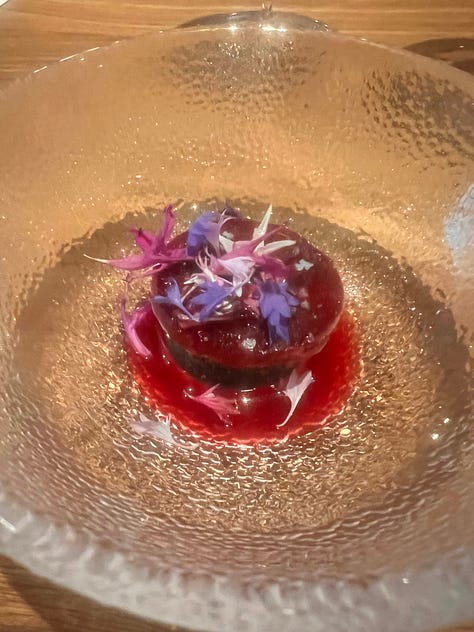Does Oregon Need the Michelin Guide?
The world is changing. How much will Portland and Oregon need to change with it?






I met Chef Matt Lightner in 2009 at a gathering of culinary professionals in Denver. Matt and I were the two youngest guys sitting at a table of food-world legends—a ten-top that included Stone Barns Chef Dan Barber, the poetic peach farmer David Mas Masumoto, and Spanish chef Andoni Luis Aduriz of Mugaritz, a San Sebastian-area restaurant where Matt was sous chef and was also ranked among the top five in the world by World’s 50Best.
I remember this dinner being the first time in my career I thought, "How the hell did I end up surrounded by my culinary heroes?" Matt likely felt the same way, and that’s probably why he and I spent two hours talking about our commonalities—our small-town, working-class upbringings; our shared love of Spain, where I’d lived in 2005-2006; and a shared belief that Oregon could be one of the foremost culinary regions in the world—if it could only get out of its own way.
Matt had history in Oregon too, having followed his siblings out West from Nebraska, landing in Portland where he enrolled in chef school and spent a few years working at The Heathman, Laslow’s, and other important restaurants of that era before heading to Southern California and later Spain, where he spent more than two years.
After our dinner in Denver, I didn’t expect to see Matt again so soon, but he texted me about a month later, letting me know he was in Portland visiting his sister. Over lunch, I learned his Spanish work visa hadn’t been renewed—and after a few job opportunities at some of the most prominent restaurants in America didn’t pan out due to the economic downturn, Matt was open to any idea—including returning to Portland. About three weeks later, he accepted the executive chef job at Castagna, as the restaurant’s then-chef Elias Cairo was leaving to start a charcuterie company with his sister, which later became Olympia Provisions.
Early 2009 was tough in the restaurant world. You could still smell the blood from October’s financial crash, and amid the Great Recession that followed, hope felt in short supply. Unemployment was high, and the shortage of discretionary income meant most restaurants were struggling. And with the near-collapse of the banking system, start-up capital was nearly impossible to get, so restaurant openings were scarce—even though the mix of unemployed workers, vacant lots, and a lack of capital led to Portland’s food cart boom (but that’s a story for another day).
At the time, I was contributing food editor and restaurant columnist for Portland Monthly Magazine, and I had been tasked to lead the International Association of Culinary Professionals conference that would land in Portland the following year, bringing with it luminaries like Judith Jones, Thomas Keller, Ruth Reichl, Madhur Jaffrey, and Michael Ruhlman to town. Meanwhile, Matt’s connections were global, having worked at the two-Michelin-starred Mugaritz and spent a few months at Copenhagen’s Noma, which was not-so-quietly becoming the most influential restaurant in the world. Matt also had deep connections in food media from his time in Spain.
Back then, the culinary landscape in America was shifting, and Portland was one of the epicenters—moving away from white tablecloths, celebrity chefs, and crunchy farm-to-table restaurants toward casual dining, third-wave coffee, neighborhood-driven spots, and street food. Like today, it was an uncertain but exciting time, but back then Oregon had all the raw materials—cheap real estate, great ingredients, world-class wines, a dramatic landscape, and an iconoclastic food scene that was years ahead of its time.
In addition to the culinary talent, there was a small group of us in our early thirties working at various institutions in Oregon who were committed to bringing the culinary world to Oregon in a big way—namely Stephany Boettner, who led the marketing team at the Oregon Wine Board, and Colu Henry, a New York transplant who’d represented some of the country’s top restaurants at Baltz & Company before falling in love with Oregon pinot noir and taking the top PR job at the Oregon Wine Board.
The year 2009 was special, but the reception of Castagna was no different than the reception of Okta. Local reviews were good, but they lacked understanding and the context of Matt’s global view. Because Portland is the type of place (then and now) where diners and food media often don’t have the confidence or worldview to make up their own minds about food that pushes boundaries, it wasn’t until Matt was named one of Food & Wine’s Best New Chefs in 2010 that local media started paying attention. After that, Castagna got busy.
More than any other chef in my career, Matt opened my eyes to a world I didn’t know existed. Thanks to his connections, we went to Madrid Fusion in Spain, where Ferran Adria and Rene Redzepi were the keynote speakers, and I also joined him on a trip to Copenhagen, paid for entirely by the Danish government, which saw the value in bringing the culinary world to experience the many infrastructural layers they had built to support the New Nordic movement. When Matt was invited to cook at the Best New Chef gala at the Aspen Food & Wine Classic, Stephany, Colu, and I put together a few side events to showcase Oregon wines and ingredients. Colu’s media connections opened doors that benefited all of us. From a Wines of Spain party that featured Chef Jose Andres cutting and doling out Jamon Iberico like sacrament, and an afternoon pork bun party hosted by Chef David Chang, I had never experienced that level of access.
For me, these experiences laid the foundation for what became Feast Portland a few years later. On top of that, the IACP conference was a big success in Portland, and my client list grew to include the largest food and wine festival in Texas, as well as helping friends in New York launch the first Eater Awards. (I had been one of the two founding editors of Eater Portland in 2009, which is how I made that connection.) We were all excited about the future and were committed to creating a major food festival in Portland.
And then everything changed.
Despite growing national press and accolades, Castagna in Portland still sputtered along. So it wasn’t surprising when, in early 2011, a group of New York City investors made Matt an offer he couldn’t refuse—essentially a blank check to relocate to New York City and create what became Atera, where Matt earned two Michelin stars and international recognition right out of the gate.
Meanwhile, Colu and Stephany both left town—Stephany to take the head marketing job at Heath Ceramics, and Colu back to New York to lead PR at a revamped Bon Appétit. For a while, I thought about leaving Portland too. All my collaborators were gone, and I had clients in Texas, New York, and California—but none in Portland.
In the end, everything worked out. My future Feast co-founder, Carrie Welch, moved to town in 2011, and Feast was launched the following year. Thanks to Colu and our friend, restaurant editor Andrew Knowlton, Bon Appétit became Feast Portland’s media partner when we launched in 2012.
As long as I’ve known Matt, he always had a vision for a destination wine country restaurant in the Willamette Valley—a world-class spot that would combine farming, fermentation, and technique to create a new definition of local and seasonal cuisine, focusing less on the broad definition of the season in favor of a philosophy defined by the moment. It took a decade, but that vision became Okta, which closed three weeks ago. Like Castagna, the local reviews were just fine, but didn’t grasp the global conversation in which a place like Okta exists.
It’s unfortunate that The Oregonian, the region’s largest print media platform, largely ignored Okta during its two-year run, only publishing a brief posthumous article with the sole takeaway being what seemed like a knock on its price per head, which was $290 including gratuity at the time of closure. This point of view struck me as contradictory, given that The Oregonian’s top-rated Portland restaurant, Nodoguro, charges $250 per head—a slightly lower but still comparable amount. To be clear, this isn’t a knock on Nodoguro, which fully deserves its top spot and has a justifiable price point because creating food at this level comes with significant labor and food costs. I just wish The Oregonian would have had more to say about Okta, considering the ambition of the project.
Throughout, Matt was doing his part, hosting some of the world’s top food writers—from Japan, Germany, the UK, and more—many of whom called Okta one of the most exciting dining experiences in the world. Plus, last year, Matt was one of only two American chefs (the other being Jose Andres) to be invited to participate in the Gastronomika conference in San Sebastian, where Matt lectured to a group of international chefs and media about the merits of Oregon’s food and beverage ecosystem.
Buzz was building, but with wine country visits down (Oregon is not alone—overall domestic tourism is down), and with the hurdles that Oregon restaurants face in reaching the type of global platforms that elevate restaurants like Okta into the proper conversation, it was too little too late.
Yesterday, Malia Spencer of The Portland Journal published an excellent, well-researched piece on Portland’s lack of the Michelin Guide—a globally recognized, Paris-based restaurant guide that sets the gold standard across Europe, Asia, and increasingly the U.S. Regions like Colorado, North Carolina, Georgia, and Texas have recently made the significant financial investments to cover the travel costs of Michelin inspectors, enabling their own regional guides to come to life. Today, the guide exists in 15 states as more and more U.S. regions are seeing the importance of reaching the Michelin Guide audience.
Maybe it's because the Michelin Guide's star system gets all the attention, or because everyone knows some wealthy traveler who boasts about how many Michelin-starred restaurants they’ve visited—and that you haven’t. Or maybe it's simply because the guide comes from France. Whatever the reason, in the United States Michelin's reputation seems inseparable from a vision of elitism—which is unfortunate considering this view of Michelin doesn’t grasp the full picture of what it does within the culinary world.
A friend in Madrid describes the Michelin Guide as "the Google Maps of the late 1900s," referencing its origins as a travel guide that included maps along with restaurant reviews. Over time, Michelin’s restaurant reviews gained prestige, becoming the most respected accolades in the culinary world. While Michelin stars dominate conversations in the U.S., regional guides paint a broader picture of local dining. For instance, the Spanish Michelin Guide features over 1,300 restaurants, though fewer than 25 percent have stars. A more fitting comparison for Oregon might be Slovenia’s guide, which highlights 63 restaurants, only ten of which are starred.
Malia’s article does a great job capturing the full scope of sentiments that usually arise when the Michelin Guide is being talked about in Oregon. Some chefs believe the state is at a disadvantage without it, while others worry that Michelin would create pressure for uniformity, leading restaurants to conform to the tastes and expectations of its inspectors, potentially fostering a sense of sameness.
In the end, the truth likely lies somewhere in the middle. In 2024, American food media and organizations like the Beard Foundation seem to be in a state of stasis. While landing on a prestigious list or winning a James Beard Award is still significant for a region, most chefs will tell you that in today’s social media and short attention age, these accolades don’t elicit the same reaction (or number of bookings) as they did a decade ago. And despite its traditionally inward-looking culinary and cultural landscape, the United States is starting to become a bigger player in the global culinary conversation—drawing increased attention from organizations like Michelin and the World’s 50 Best, which for the first time this year hosted its annual unveiling of the world’s top 50 restaurants in the United States. Granted, the event took place in Vegas, but it attracted hundreds of the world’s top chefs and food/travel writers to North America, and tourism boards around the country were smart to lure them into their own regions while they were on American soil.
So in short, things are changing,
As for me, I don’t believe that Oregon is a "copy-and-paste" kind of place—but that also doesn’t mean we should isolate ourselves. Any efforts we devote to attracting Michelin and/or other globally significant platforms must be undertaken with a big-picture, long-term view of what we’re trying to build. This will not only be necessary to garner the right type of attention and to tell Oregon’s story in its best light, but it will also be crucial in selling the idea of Michelin to Portland restaurants that aren’t Michelin material. And to be clear, there’s absolutely nothing wrong with not making the cut. San Francisco, Paris, Lyon, Turin, and Mexico City all have their own Michelin Guides, yet it would be hard to argue that these places are somehow less original because of it.
However, culturally in Portland, there’s often a groupthink mentality where every move must directly benefit every player—and have their buy-in. I believe, more than anything, this is what truly holds us back as a city, and we must move on. As our region grows, and considering the current challenges we’re facing, I believe it’s time for all of us to think differently about how we engage with the rest of the world and find our comfort as a player within it.
At the end of the day, Oregon is a place that truly is world-class. It produces some of the best ingredients in the world and offers remarkable products and experiences—none of which come cheap. Our future success will depend, in part, on recognizing that Oregon’s production is reliant on those with the discretionary income and wealth to purchase these things—whether it’s a $500 knife, a $200 bottle of wine, or a dinner for two that exceeds $1,000. If we truly value good ingredients, fair wages, and believe our state is worthy of livability, we must also become more comfortable with our role in producing such things. To reach those audiences, we’ll need to expand beyond the ones we’re currently reaching—whether that’s through Michelin or another way.
In an article about Michelin, you may find it odd that it’s taken me more than 2,000 words to get to my point, but as always, I believe that personal narratives—yours, mine, and everyone’s—are ultimately what matter. Cities, after all, are nothing more than the sum of everyone’s collective stories—a pile of narratives not so neatly stacked.
But for 15 years, as I’ve connected with people globally in the food world—whether with and through Matt or others—people are often surprised that Oregon isn’t part of the Michelin Guide. And this is because Michelin, whether you like it or not, is perhaps the most major player in the global gastronomic scene. It’s also true that Michelin is known for connecting restaurants like Okta with the kind of audience they need to survive. And that’s a fact.
And if that investment is what will retain our very best talent, then it is at least worth a conversation.




What would it take to get us in the Michelin guide, in terms of direct investment and infrastructure required to support it? In getting to know you and your focus on the food world, it has become so clear to me that the idea people aren't talking with the funders and none of them have a clear inroad to the public sector. I thought this was a really nuanced piece. We should figure out the throughline so that our business community and government folks can understand this better and see their role in helping.